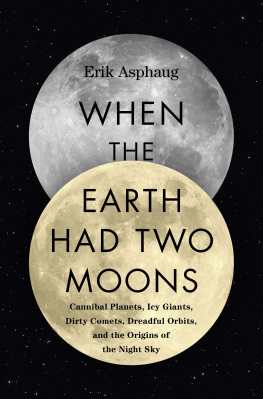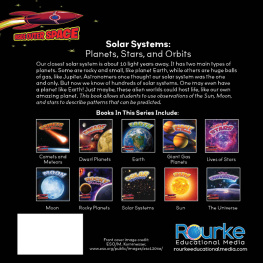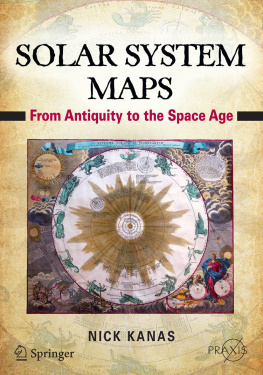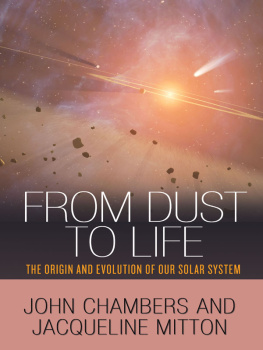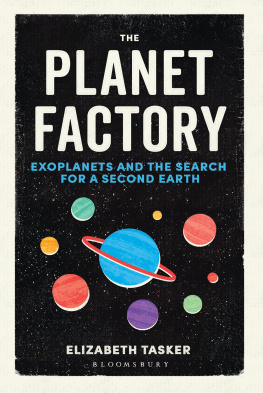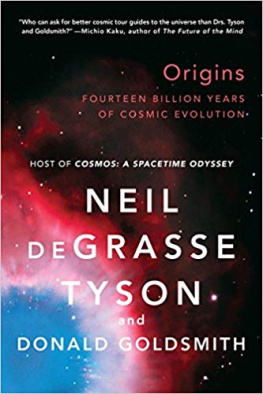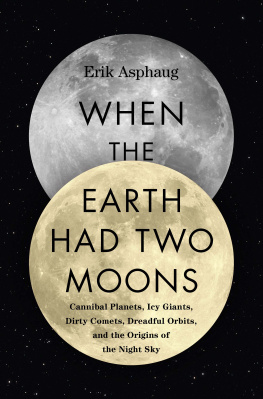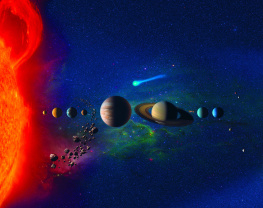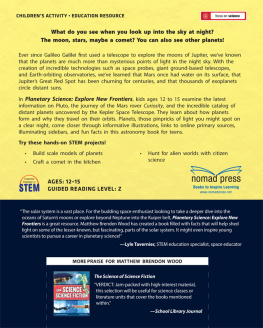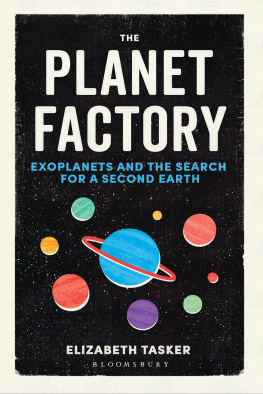To Henry, Galen, and Phoebe
WHEN THE EARTH HAD TWO MOONS . Copyright 2019 by Erik Asphaug. All rights reserved under International and Pan-American Copyright Conventions. By payment of the required fees, you have been granted the nonexclusive, nontransferable right to access and read the text of this e-book on-screen. No part of this text may be reproduced, transmitted, downloaded, decompiled, reverse-engineered, or stored in or introduced into any information storage and retrieval system, in any form or by any means, whether electronic or mechanical, now known or hereafter invented, without the express written permission of HarperCollins e-books.
Cover design by Keith Hayes
Cover photograph colordream00 / Multi-bits / Getty Images (background); samxmeg / istock / Getty Images (2 moons)
Title page art Vadim Sadovski / Shutterstock
FIRST EDITION
Digital Edition OCTOBER 2019 ISBN: 978-0-06-265794-7
Version 09272019
Print ISBN: 978-0-06-265792-3
There are at least nine planets in the solar system (depending on whos counting) and they have almost two hundred known moons (natural satellites). Below are some of the most interesting and important ones. Because some of the moons are oddly shaped, and the fast-rotating planets are oblate, whats given is the average diameter. Orbital distances of planets are in AU, where 1 AU is the Earths average distance from the Sun, 149.6 million kilometers. The orbital distances of satellites are given in units of their planetary radius.
MERCURY
Distance from Sun: 0.39 AU
Diameter: 4,878 km
Mass: 3.301 1023 kg
Orbital period around the Sun: 0.24 years / 88 days
Spin period: 58.6 days
VENUS
Distance from Sun: 0.72 AU
Diameter: 12,104 km
Mass: 4.867 1024 kg
Orbital period around the Sun: 0.62 years / 226 days
Spin period: 243 days (retrograde)
EARTH
Distance from Sun: 1 AU (defined)
Diameter: 12,742 km
Mass: 5.972 1024 kg
Orbital period around the Sun: 1 year / 365.26 days
Spin period: 23.93 hours (sidereal day)
Moon
Distance from planet: 60.3 Earth radii
Diameter: 3,474 km
Mass: 7.35 1022 kg
Orbital period around Earth: 27.3 days (sidereal month)
MARS
Distance from Sun: 1.52 AU
Diameter: 6,779 km
Mass: 6.417 1023 kg
Orbital period around the Sun: 1.88 years
Spin period: 24.6 hours
Phobos
Distance from planet: 2.8 Mars radii
Diameter: 22 km
Mass: 10.8 1015 kg
Orbital period around Mars: 7.7 hours
Deimos
Distance from planet: 7.0 Mars radii
Diameter: 12 km
Mass: 1.48 1015 kg
Orbital period around Mars: 30.3 hours
JUPITER
Distance from Sun: 5.2 AU
Diameter: 139,822 km
Mass: 1.898 1027 kg
Orbital period around the Sun: 11.86 years
Spin period: 9.9 hours
Io
Distance from planet: 6.03 Jupiter radii
Diameter: 3,643 km
Mass: 8.93 1022 kg
Orbital period around Jupiter: 1.8 days
Europa
Distance from planet: 9.59 Jupiter radii
Diameter: 3,130 km
Mass: 4.79 1015 kg
Orbital period around Jupiter: 3.6 days
Ganymede
Distance from planet: 15.30 Jupiter radii
Diameter: 5,268 km
Mass: 1.48 1023 kg
Orbital period around Jupiter: 7.2 days
Callisto
Distance from planet: 26.93 Jupiter radii
Diameter: 4,806 km
Mass: 1.08 1023 kg
Orbital period around Jupiter: 16.7 days
SATURN
Distance from Sun: 9.6 AU
Diameter: 116,464 km
Mass: 5.683 1026 kg
Orbital period around the Sun: 29.44 years
Spin period: 10.7 hours
Mimas
Distance from planet: 3.18 Saturn radii
Diameter: 398 km
Mass: 3.75 1019 kg
Orbital period around Saturn: 0.942 days
Enceladus
Distance from planet: 4.09 Saturn radii
Diameter: 504 km
Mass: 1.08 1020 kg
Orbital period around Saturn: 1.37 days
Tethys
Distance from planet: 5.06 Saturn radii
Diameter: 1,072 km
Mass: 6.17 1020 kg
Orbital period around Saturn: 1.89 days
Dione
Distance from planet: 6.48 Saturn radii
Diameter: 1,125 km
Mass: 1.10 1021 kg
Orbital period around Saturn: 2.74 days
Rhea
Distance from planet: 9.05 Saturn radii
Diameter: 1,528 km
Mass: 2.31 1021 kg
Orbital period around Saturn: 4.52 days
Titan
Distance from planet: 21.0 Saturn radii
Diameter: 5,150 km
Mass: 1.34 1023 kg
Orbital period around Saturn: 15.9 days
Hyperion
Distance from planet: 25.7 Saturn radii
Diameter: 270 km
Mass: 1.08 1019 kg
Orbital period around Saturn: 21.3 days
Iapetus
Distance from planet: 61.1 Saturn radii
Diameter: 1,469 km
Mass: 1.81 1021 kg
Orbital period around Saturn: 79.3 days
URANUS
Distance from Sun: 19.2 AU
Diameter: 51,26 km
Mass: 8.681 1025 kg
Orbital period around the Sun: 84.02 years
Spin period: 17.2 hours (retrograde)
Miranda
Distance from planet: 5.08 Uranus radii
Diameter: 472 km
Mass: 6.59 1019 kg
Orbital period around Uranus: 1.41 days
Ariel
Distance from planet: 7.47 Uranus radii
Diameter: 1,160 km
Mass: 1.3 1021 kg
Orbital period around Uranus: 2.52 days
Umbriel
Distance from planet: 10.4 Uranus radii
Diameter: 1,170 km
Mass: 1.17 1021 kg
Orbital period around Uranus: 4.14 days
Titania
Distance from planet: 17.1 Uranus radii
Diameter: 1,577 km
Mass: 3.53 1021 kg
Orbital period around Uranus: 8.71 days
Oberon
Distance from planet: 22.8 Uranus radii
Diameter: 1,523 km
Mass: 3.03 1021 kg
Orbital period around Uranus: 13.5 days
NEPTUNE
Distance from Sun: 30.0 AU
Diameter: 49,244 km
Mass: 1.024 1026 kg
Orbital period around the Sun: 165 years
Spin period: 16.11 hours
Proteus
Distance from planet: 3.77 Neptune radii
Diameter: 420 km
Mass: 4.4 1019 kg
Orbital period around Neptune: 1.1 days
Triton
Distance from planet: 14.4 Neptune radii
Diameter: 1,682 km
Mass: 2.14 1022 kg
Orbital period around Neptune: 5.9 days
Nereid
Distance from planet: 224 Neptune radii
Diameter: 340 km
Mass: 3.09 1019 kg
Orbital period around Neptune: 360 days
PLUTO
Distance from Sun: 39.5 AU
Diameter: 2,377 km
Mass: 1.303 1022 kg
Orbital period around the Sun: 248 years
Spin period: 6.39 days (retrograde)
Charon
Distance from planet: 16.5 Pluto radii
Diameter: 1,212 km
Mass: 1.55 1021 kg
Orbital period around Pluto: 6.39 days
Nix
Distance from Pluto-Charon barycenter: 41 Pluto radii
Diameter: 74 km
Mass: 4.5 1016 kg
Orbital period around Pluto-Charon: 24.9 days
Hydra
Distance from Pluto-Charon barycenter: 54.5 Pluto radii
Diameter: 38 km
Mass: 4.8 1016 kg
Orbital period around Pluto-Charon: 38 days
HAUMEA
Distance from Sun: 43 AU
Diameter: 1,436 km
Mass: 4.0 1021 kg
Orbital period around the Sun: 284 years
Spin period: 3.9 hours
Namaka
Distance from planet: 48.2 Haumea radii
Diameter: 170 km
Mass: 1.8 1018 kg
Orbital period around Haumea: 34.7 days
Hiiaka
Distance from planet: 60.7 Haumea radii
Diameter: 310 km
Mass: 1.8 1019 kg
Orbital period around Haumea: 49.1 days
Time is the father of truth. Its mother is our mind.
GIORDANO BRUNO
I WAS BORN IN NORWAY IN October, so half a year went by before I had my turn lying on my back in the soft grass, gazing into the sky after sunset. (Never disturb a baby who is staring at the sky.) Still, occasionally through the dark winter I would have found myself outside, bundled up in a pram on a walk from here to there. I have no real memory of it, of course, but Im pretty sure that my first sight of the Moon was of a cold crescent set against dark indigo among a few sparkling gemsa vision that through my life has stopped me in my tracks. Since then, perhaps because of that, Ive been a student of planets.
Next page
